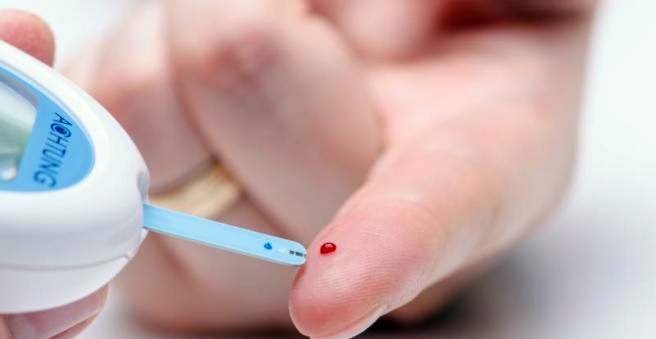A diabetes test should determine whether you are suffering from diabetes. For this the blood and the urine are examined and if necessary an oral glucose tolerance test (oGTT) is carried out. A home-use diabetes self-test may be for guidance only and should not replace a doctor’s visit. Learn how the various investigations are going and what the results reveal.

How does the doctor diagnose diabetes mellitus?
For a reliable diagnosis of diabetes, a visit to a doctor is indispensable. The examinations can be carried out either by the family doctor or a specialist in internal medicine and endocrinology (diabetologist). A detailed preliminary discussion and the general physical examination are the basis of the diagnosis. There are also several special examinations:
Measurement of fasting blood sugar
Particularly important is the fasting blood glucose determination. It is important that no food and at most unsweetened and calorie-free drinks such as tea or water are consumed eight hours before taking blood always in the morning.
In healthy people, fasting blood sugar is between 65 and 100 milligrams per deciliter (mg / dl). At values between 100 and 125 mg / dl there is already a disturbed sugar metabolism (prediabetes) but no overt diabetes mellitus. For multiple fasted blood glucose levels (on different days) above 125 mg / dl, the diagnosis of diabetes mellitus is likely.
Oral glucose tolerance test
The oral glucose tolerance test (oGTT) is a diabetes test that can more accurately assess the performance of glucose metabolism. It is used when there is a suspicion that there is a precursor to diabetes (prediabetes) due to latent increases in fasting blood sugar levels. In pregnancy, the test is routinely performed to detect gestational diabetes in good time. In an already known diabetes mellitus, the test must not be used because the blood sugar levels could rise dangerously.
Fasting blood sugar is determined at the beginning of this diabetes test. The patient then drinks a sugar solution with 75 grams of glucose within a short time. Two hours later blood is again taken and the blood sugar is determined. Compared with the fasting blood glucose value, it can be calculated how much of the absorbed glucose could be utilized by the body within the last two hours. If the blood glucose level is at or above 200 mg / dl, the diagnosis “diabetes mellitus” is very likely. Values between 140 and 200 mg / dl speak for a so-called prediabetes, ie a precursor of the disease with already impaired glucose utilization.
Diabetes urine test
Also, a urine test is one of the standard tests for diabetes. Normally, there is little or no sugar in the urine, because the kidney retains it during blood filtration (absorbed). However, if the blood sugar level is significantly increased, the kidney’s ability to resorb is no longer sufficient. The urine contains glucose and the test field on the diabetes test strip changes color.
However, a positive diabetes urine test is not yet evidence of diabetes, but merely the starting point for further investigation. This is important to know for people who use the test strip as a diabetes self-test: Even with other diseases, especially the kidney, or after small “nutritional sins”, the sugar content in the urine may increase and the “diabetes test” positive.
If the doctor lets the urine be examined in a laboratory, he can additionally determine other values, for example the protein content in the urine. If a diabetes that has not been discovered for a long time has already damaged the kidney (diabetic nephropathy), it is often elevated.
HbA1c
The so-called HbA1c value is the proportion of the red blood pigment hemoglobin that has entered into a connection with sugar molecules in the blood – the so-called glycohemoglobin A. In healthy individuals with permanently normal blood glucose levels, the proportion of HbA1c is below 6.5 percent. However, if the blood glucose levels are increased in phases or permanently, the HbA1c level increases as well.
Once the connection between red blood pigment and glucose has been maintained, the red blood cells live. Therefore, one can use the HbA1c value as a blood glucose long-term memory: It allows conclusions about the blood sugar history of the past two to three months and is thus well suited for the follow-up of diabetes and the success of therapy. As a sole value, he is not suitable for diabetic diagnosis.
Diabetes self-test
Diabetes is a chronic disease with sometimes serious consequences. Therefore, healthy people are recommended to be tested regularly for diabetes. This is especially true when cases of diabetes have already occurred in the family. Some test methods are also suitable for self-implementation. Although they do not allow a reliable diagnosis, a positive finding should, however, entail a more extensive medical examination.
Diabetes test strips
Most pharmacies carry out a cheap diabetes test for self-implementation. This is a simple variant of the urine test described in detail above. The test strip is held briefly in urine stream while urinating. If the test field is discolored, sugar is present in the urine. It should then be initiated by the doctor, a more advanced diabetes diagnostics.
Online Diabetes Risk Test
The personal risk of developing diabetes within the next ten years can be determined using the FINDRISK online questionnaire developed by the German Diabetes Foundation and the German Diabetes Association. He asks questions about age, diabetes in the family, body weight and diet, and specific lab values. Although he can not replace a doctor’s visit, he allows important early conclusions on how to reduce the risk of diabetes.
The same applies to the German Diabetes Risk Test of the German Institute for Nutrition (DIfE) for persons between 35 and 65 years. It is based on findings from a large European study (EPIC Study – European Prospective Investigation into Cancer and Nutrition). He is not Diabetes Test in the narrower sense, but can help to recognize the risk of disease early and reduce.